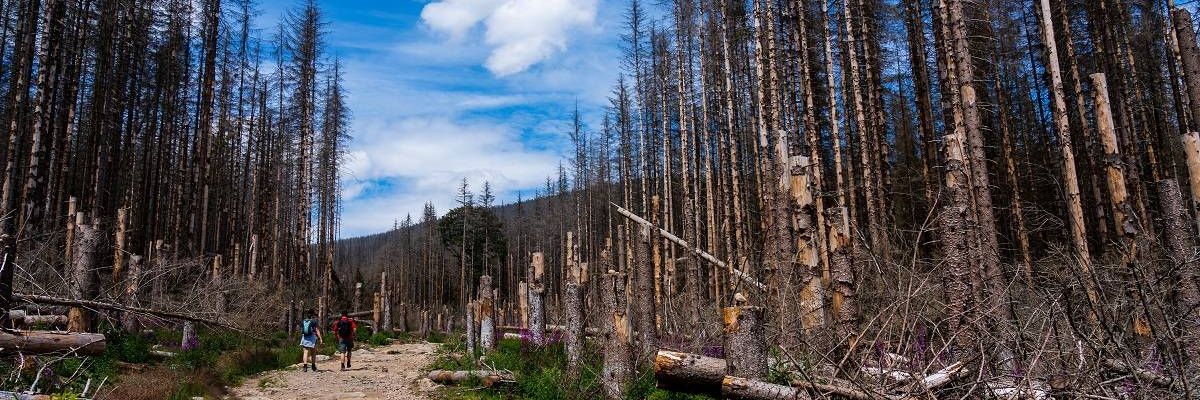
Forests as a human creation: are they in crisis or is it our view of them?
25. 07. 2022
Threatened by drought and the bark beetle, disappearing before our very eyes, they are in crisis – just a few things people say about forests. But perhaps it is actually our view of forests as we have created them in our imaginations which is in crisis. Read on for the main topic of the current Czech issue of the CAS A / Věda a výzkum magazine.
Mostly bare, plundered land. Only a few trees left alive in hard-to-reach places. Further use of wood will be possible only in decades to come... The reality of Czech forests in the 21st century? No. This is what the eastern Krkonoše Mountains looked like in 1609. At least according to the report of a committee of foresters from Žacléř, the chief gamekeeper from Trutnov, and a group of mining officials from Kutná Hora who hiked to the Sněžka Mountain on 16 September of that year. The officials stated that the timber was completely exhausted, recommending that the grazing of goats and cattle in the forests be banned immediately, the loggers’ cabins be removed from the forests, and the forest workers be relocated to the Orlické Mountains.
Back then, almost the entirety of the forests of the eastern Krkonoše Mountains were cleared in just a few decades. A massive amount of timber was felled for the needs of the silver mines in Kutná Hora, to which it was transported by means of a 130-kilometre-long waterway down the Elbe River, the Úpa River, and their tributaries. The sophisticated mining and transport system for the log driving and timber rafting of Krkonoše timber was built by Tyrolean experts after 1566. Thanks to this system, logging in the area could reach up to 80,000 cubic metres annually in the 1560s–1580s. A similar plundering of the neighbouring Orlické Mountains was eventually prevented by the decline of silver mining in Kutná Hora and the Thirty Years’ War.
“Records of the unfortunate state of the forests and the lack of resources for various manufacturing operations can be found in written sources from the late Middle Ages, the early modern period, and the 19th century alike,” says Jiří Woitsch from the Institute of Ethnology of the CAS, whose research focuses on the history of human impact on forests. A certain “rhetoric of catastrophe” permeates the entire modern history of European forests and is a specific feature of (not only) Czech forestry discourse. We can find it in 16th-century statutes and in the Theresian Forest Order of 1754. The conviction that forests were in danger of disappearing and that soon there would not be much wood left to harvest led to the birth of modern forestry, which was put into practice in the 19th century and has determined the shape of the Central European forest ever since.
So what do today’s Czech forests look like, and should we fear the catastrophic scenarios of the past? How will forests be affected by ongoing climate change and the accompanying drastic droughts and unpredictable weather whims such as hurricanes and tornadoes? Isn’t it time for a radical change in forestry management?
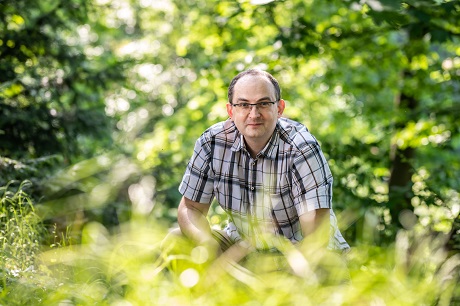
PhDr. Jiří Woitsch, Ph.D. (Institute of Ethnology of the CAS). He studied ethnology and history at the Faculty of Arts at Charles University in Prague. He focuses on forgotten forest crafts – pottery, coal mining, etc. He is the head of the Department of Critical Heritage Studies and the director of the Institute of Ethnology of the CAS.
What is and isn’t a forest?
An ecologist, botanist, zoologist, or climatologist will perceive the forest very differently than a forester or gamekeeper, just like a mushroom picker or a tourist will have a vastly different view of the forest. For each of them the forest is important, and all of them are likely to love and care about it. But it is less certain that they will agree on what it should look like, what role it should play, and which functions it should fulfil.
We all come into contact with the forest somehow, we all think of it in a certain way and have a relationship with it. Therefore, purely biological knowledge is insufficient for a more comprehensive understanding of what happens in and to forests. “Fellow naturalists are very good at understanding the natural processes of how forests function. However, humans and human society in general often behave in a way that is in contradiction to scientific knowledge. And that’s where we come in,” says ethnologist Jiří Woitsch.
The social sciences and humanities can provide insight into how people perceive forests, how they relate to them, and how they approach them. They can also reveal stereotypes and romanticised ideas of what a forest “should look like”. “Social sciences can help unravel the complex relationship between society and forests, and thus contribute to understanding its consequences, which are reflected in the current constitution and appearance of forests,” adds Jana Stachová from the Institute of Sociology of the CAS, whose work has focused on this topic for a long time.
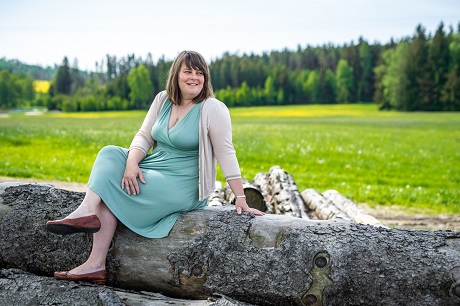
PhDr. Jana Stachová, Ph.D. (Institute of Sociology of the CAS). She studied sociology at the Faculty of Social Sciences at Charles University in Prague. She is a research assistant at the Department of Local and Regional Studies of the Institute of Sociology of the CAS. Her research focuses on environmental sociology and the relationship between humans and landscapes.
Spruce trees. Spruce trees everywhere…
Due to the bark beetle calamity and prolonged periods of drought, in the past few years, the forest landscape in the Czech Republic has changed beyond recognition. In the Vysočina region or the Hostýnské vrchy in Moravia, for example, whole sections of spruce forests have disappeared and hills, previously covered by dense vegetation, have revealed their contours. However, damaged trees can now be found in all regions of the Czech Republic, including the national parks.
Spruces, long considered an ideal tree species because of fast growth and relative ease of processing, account for about half of all forest cover in the Czech Republic. Due to the effects of climate change, it is becoming increasingly more apparent that this type of forest is not sufficiently resilient enough and spruce-dominated forest management may not actually pay off.
Forestry strategy plans and governmental policies are also taking this into account. The Czech State of the Environment Report from 2020 mentions that the proportion of spruce in forests has fallen from 54% to 48.8% over the last 20 years, the aim being to reduce it to below 37%. In 2019, for the first time in history, foresters reforested a larger section of forest with deciduous instead of coniferous trees as part of artificial reforestation. A year on this trend was continued, with reforestation statistics showing a record 17,300 hectares of new broadleaf trees and 16,400 hectares of coniferous trees. However, regarding both oak and beech, the proportion of these broadleaf trees of the forest composition is growing at a slower rate than planned. Beech, for instance, was supposed to increase to 18%, but in reality, its percentage has risen only slightly, from 6% to 9% (oak from 6.3% to 7.5%).
There are several reasons for the failure to enrich the species composition of forests. The report of the Czech Ministry of the Environment (scroll down for English version) also mentions damage caused by wild animals (in other words, trees are planted but do not survive because they are eaten by forest wildlife).
Spruce plantations as wheat fields
In Central Europe, the “spruce monoculture forest” began to take hold less than two hundred years ago, essentially replicating the agrotechnical system established in agriculture, applying a cycle of planting – growing – harvesting – replanting and so on. One of the dominant types became the “single-species even-aged stands” – that is, a forest of trees of roughly the same age and similar stature which are then cut down all at once, i.e., the process of clearcutting.
The point was to make enough wood available to use for construction and industry purposes. In the 19th century, industry was booming and construction was rapid, with railways being built, and a significant amount of wood was needed for all this.
But it soon became clear that uniform spruce forests are very vulnerable. Spruces designated for felling do not have time to grow and develop a stable root system, and they are not protected against strong winds by stands of other or mixed species. Moreover, forest engineers would also plant spruce trees in completely unsuitable places, for example in drought-prone areas. In many of these areas, foresters would even plants these single-species and even-aged forests several times in succession on the same site, which meant that the same nutrients were used over and over again and therefore the pH of the soil changed.
The vulnerability of spruce monocultures was acknowledged by some foresters as early as the 19th century. In 1868, a huge windstorm caused damage throughout what is now Czech Republic, followed by an unparalleled bark beetle calamity. This was something unprecedented for the foresters of that generation; the last major storm was in 1833 and was far from reaching such magnitude.
In response to the disaster, experts began to wonder whether the damage could have been prevented and how to prepare for a possible recurrence. Some mentioned the need to plant more resilient tree species (such as larches), pointing out the unnaturalness of monocultures. “No mistakes are as severely punished as those made by man against the infallible laws of nature,” one forester was then quoted as saying. As Péter Szabó, a forest historian from the Institute of Botany of the CAS, demonstrates, pragmatic and to some extent fatalistic reasoning eventually prevailed. Two other statements at the time testify to this: “It is impossible to withstand such massive storms”. “Such storms are beyond all forestry experience, beyond our principles of forestry, completely defying them.”
In fact, similar discussions reappear regularly after almost every major natural disaster. When Cyclone Kyrill struck in 2007, completely destroying almost 10 million cubic metres of timber (especially in Šumava, the Bohemian Forest), statements were made that were almost identical to those Péter Szabó had discovered in archival materials from the 19th century. “Although the current bark beetle calamity seems to be reaching truly exceptional proportions, this does not necessarily mean it will lead to any significant change in thinking about forests,” the historian says.
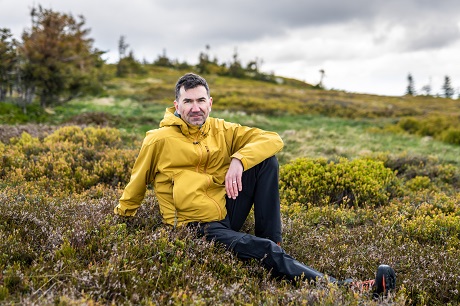
Mgr. Péter Szabó, Ph.D. (Institute of Botany of the CAS). He studied history and English and defended his PhD on medieval forest history in 2003 at the Central European University in Budapest. In the Department of Vegetation Ecology at the Institute of Botany of the CAS, he works on historical ecology, especially the development of Central European forests.
Is it forests or forestry that are in crisis?
In light of the current bark beetle calamity, drought, and frequent windstorms, there is often talk of a “forest crisis”, or of forests being at severe risk or even being wiped out. The catastrophe of Czech forests is reported in the news, friends share their anxiety at the sight of bark beetle-eaten forest stands, and mushroom pickers cannot recognise their favourite places. But the current state of the forest is not necessarily a disaster in itself. It is a transitional state that is constantly evolving. “The forest cannot even be in a crisis. As soon as we leave it alone, the process of succession begins – that is, it grows back on its own as it needs to. And in fifty years or so it’s green again. It just won’t look like how we’re used to seeing it. But that’s our problem, our crisis, not the crisis of the forest,” Szabó remarks.
“We must realise that the anthropomorphic standpoint plays a role here. We humans perceive that the forest is supposed to look a certain way and suddenly it looks completely different, it doesn’t match our idea of it,” adds Péter Szabó’s colleague, vegetation ecologist Radim Hédl. Yet “the only correct notion” of the forest is different for everyone. While a mushroom picker enjoys clear coniferous forests, a member of an ecological organisation will prefer fir-beech forests. “In general, people have a greater preference for an uncluttered, well-organised forest over one in which natural processes predominate and human influence is minimal,” sociologist Jana Stachová recalls the results of public surveys.
Arguments about the poor state of forests have very old roots and have traditionally been used as a tool to enforce views regarding how forests should be managed. The situation of the ‘forest crisis’ is always recalled periodically after a disaster hits, whether it is the 21st century with bark beetles and drought, the 20th century with industrial fumes and acid rain, the 19th century with windstorms, or the previous centuries when, due to intensive forest management (glassmaking, charcoal burning, logging for firewood and construction purposes), usable timber nearly disappeared.
Lessons for the future most often concerned how to better “cultivate” forests so humans could “get something out of it”. And for at least the last 200 years, the goal of forest management in central Europe has been to grow and harvest trees according to a continuously developed plan based on economically sound principles. “Modern” foresters of the 19th century developed precise procedures for growing forests efficiently as plantations with predictable and sustainable timber yields. Forestry schools taught graduates how to calculate how much a given area would yield in the future. This was accompanied by newly defined terms such as ‘normalbaum’ and ‘normalwald’ (normal tree and normal forest), which are still used in forestry to this day.
While almost no one defends spruce monoculture plantations today, a certain conservative attitude in the forestry sector, which honours past traditions, is still present. Thus, it seems that it is not forests that are in crisis, but rather modern forestry as a kind of perception of forests that is no longer suited to new circumstances, especially those associated with global climate change.
“Similarly to railway workers, foresters also wear uniforms and have an extremely strong professional identity. Forestry high schools are often boarding schools and foster strong bonds. It is a predominantly male, strongly conservative environment,” Jiří Woitsch explains. Sociological probes also confirm the conservatism of the forestry milieu. “For centuries, foresters have been used to certain practices and laws in the field and find it very difficult to adapt to the sudden changes that are now happening on a global level,” Jana Stachová notes.
According to her findings, two currents of opinion can be traced within the Czech forestry community. “Ecological realists” have no doubts regarding the seriousness of the problems facing forests in light of climate change and have some ideas on how to go about solving them. In contrast, “traditionalists” are characterised by relativising scientific findings and scepticism towards the introduction of new management practices. In general, however, foresters are a rather closed group that is still finding its way towards more open communication with other professional groups.
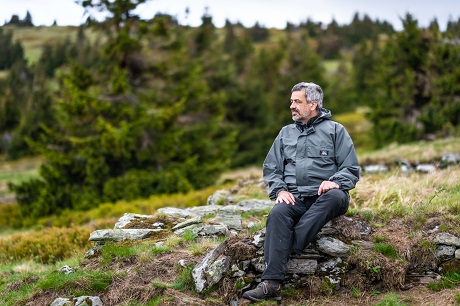
Mgr. et MgA. Radim Hédl, Ph.D. (Institute of Botany of the CAS). He studied biology and geobotany at the Faculty of Science of Charles University in Prague. In 2005 he defended his Ph.D. at the Faculty of Forestry of the Mendel University in Brno, and in addition he studied painting at the Academy of Fine Arts in Prague (2003). He heads the Department of Vegetation Ecology at the Institute of Botany of the CAS in Brno and teaches at Palacký University in Olomouc.
Turbulent changes
On the one hand, there’s the relatively conservative forestry community, while on the other, we’ve got the radical changes that have taken place in forest management in the recent past. Many of these changes have been linked to the country’s hectic political development, when different forms of land ownership changed hands, but some have deeper roots.
According to Péter Szabó, there have been four dramatic turning points in forest ownership over the last seven hundred years (three of which are recent). From the late Middle Ages until the mid-19th century, essentially the same system was in place, with ownership of (not only) forest land being divided into dominical lands and rustical lands. Land could only be owned (in today’s sense of the word) by the upper classes, i.e., the monarch, nobility, the church, and the towns. In the dominical administration the land was taken care of by the owner, while rustical land was given on permanent lease. For example, according to the Theresian land registry, at the beginning of the second half of the 18th century, 94% of all Moravian forests were under dominical administration. A radical change occurred after the abolition of serfdom in 1848. Suddenly anyone could own land. “This was a huge systemic shock for forest tenure. Formerly rustical forests could now be converted to private ones relatively easily, but the former dominical ones – that is, most of the forests – found themselves in a very complicated situation,” Szabó explains. By 1875, 90% of Moravia’s forests were already privately owned (the remaining 10% belonged to the municipalities).
For a long time, forest owners and foresters looked for ways to approach management. But then came another systemic shock in the form of the First World War and the collapse of the Austro-Hungarian Empire. In 1918, the state joined forest owners as a completely new actor. The land reform of the First Czechoslovak Republic aimed to nationalise most forests, but in practice, it left them mainly in the care of the original owners through so-called forest cooperatives. In 1937, 15% of the forests in Moravia (and Silesia) were state forests, 13% were municipal forests, and 68% were in the care of forest cooperatives.
The third major break came after the Second World War, when the state first expropriated the estates of Germans and Hungarians and the Communist regime subsequently abolished private ownership of forests altogether. By 1981, only a negligible 0.1% of the forests were privately owned. The last systemic change is mostly remembered by the general population, the one which occurred after 1989. The political regime change brought about the transition from a centrally planned economy to a market economy, and the land and estates were gradually returned to the former private owners. By the end of 2019, the state-owned Forests of the Czech Republic (Lesy ČR) were managing over 54% of all forest areas, about one fifth of the forests were owned by natural persons, and over 17% fell into the category of urban and municipal forests (the rest fell to legal entities, churches, cooperatives).
It is the turbulent changes and several total reploughing of ownership and management structures that may be one of the reasons for the dismal state of Czech forestry. Foresters themselves point out the problematic situation as well. For example, it might come as a great surprise to the public that a relatively large part of forestry work in the Czech Republic is not carried out by qualified forestry workers. “The staff of the lowest forestry order are agency-hired workers, usually foreigners from Ukraine, Moldova, and other countries. These are individuals who understandably have no emotional attachment to the place. The only criterion for the forester who gives them the job is cheap and fast work, and it’s not important whether the hired company will havoc the forest with heavy machinery,” Woitsch says.
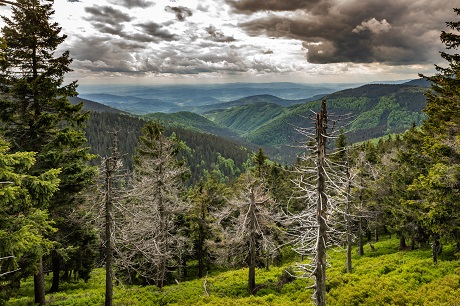
Is the future for Czech forests looking bleak, or is there a silver lining on the horizon?
A faulty system
Although foresters are the target of media and public criticism, it must be acknowledged that the current state of Czech forests cannot simply be blamed on a single professional group, but rather and likely the whole system of the management of (not only) forest land, which still bears the heavy legacy of the not entirely satisfactory post-revolutionary transformation. It is not just forestry workers, but the follow-up industry as a whole – sawmills, for example, have almost completely disappeared from our territory. In practice, timber is extracted from the Czech forests using heavy machinery for cheap, transported in trucks to Poland or Austria where it is cut and processed, and the resulting products are then brought back here for higher costs.
The forestry industry is engaged in an ongoing discussion, and the current calamity situation may lead to systemic changes as a result. For instance, the Pro Silva Bohemica association, which promotes the use of natural processes in forest management, is very active in their defence. It currently has over 200 members, including foresters and academics.
Changes at the highest level may slowly be appearing on the horizon. Not only the professional community, but also the Czech Ministry of Agriculture seems to be putting pressure on the state-owned enterprise Lesy ČR to transform the way it considers forest management. This also became evident in the unsuccessful election of a new director of the company. In February 2022, the Ministry cancelled the selection procedure because it could not find a suitable candidate. “It is very important to me that the candidates for the post of director general have the knowledge and vision necessary for the restoration of forests following the bark beetle calamity, water retention in forests, and overall strengthening of the ecosystem functions of the forest,” Czech Minister of Agriculture Zdeněk Nekula commented at the time.
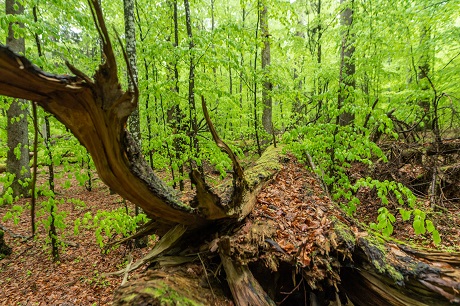
Pictured here is the Žofín Forest in the Novohradské hory (Gratzen Mountains).
Changes in sight?
The relationship or approach to land, and thus to forests as well, has been changing over the course of the last century. No longer is agricultural or forest land the sum and substance of the country’s economic wealth. According to data from the Czech Statistical Office, the agricultural sector accounts for only around 2% of the gross value added of the Czech economy. Forestry does not account for even half of this. It is therefore perhaps time to realise that the economic (production) role of forests is absolutely minimal and that picturing a “normal forest”, where it is possible to calculate how much benefit it will bring us, does not correspond to reality. Although sociological surveys show that the general public is aware of this – in a 2017 survey, 68% of respondents considered climate protection to be the most important function of forests and only 36% mentioned timber production as a key role – this conservation attitude has not yet been fully reflected in legislation and forestry practice.
The last two years have not been conducive to conceptual changes in thinking about forests. Both the government and the public have been intensively dealing with the pandemic, and since February 2022, our society has been to some extent paralysed by the war conflict on the threshold of Europe. But climate change stops for nothing and nobody and its effects are intensifying – along with its negative impact on forests. In the early modern period, we partially decimated numerous forest stands through inappropriate management, as the story at the beginning of the article revealed. In the first half of the 17th century, the Orlické Mountains were saved from the fate of the plundered Krkonoše Mountains only by the arrival of the Thirty Years’ War. Today, we face slightly different problems than those of intensive logging, but let us hope that we will be able to find a peaceful resolution as part of a society-wide debate.
The full article (in Czech) can be found in the CAS A / Věda a výzkum magazine:
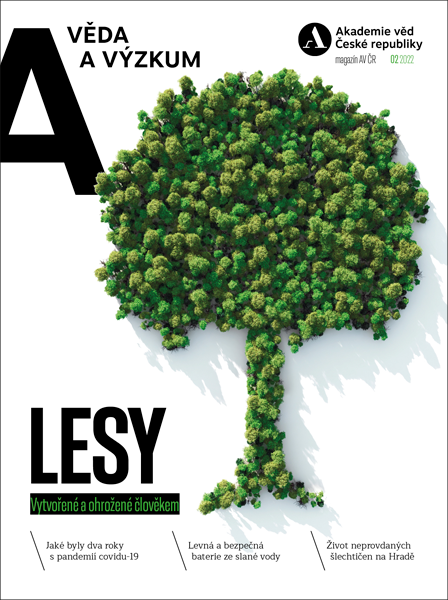
2/2022 (version for browsing)
2/2022 (version for download)
Prepared by: Leona Matušková, Division of External Relations, CAO of the CAS
Translated by: Tereza Novická, Division of External Relations, CAO of the CAS
Photo: Jana Plavec, Division of External Relations, CAO of the CAS; banner photo: Shutterstock
 The text and photographs are released for use under the Creative Commons licence.
The text and photographs are released for use under the Creative Commons licence.
Read also
- SUNER-C concludes after three years dedicated to the renewable energy future
- A trapped state: The pandemic impact on public attitudes, trust, and behavior
- Aerial archaeology: Tracing the footsteps of our ancestors from the sky
- Archaeologists uncover ancient finds along Prague Ring Road
- Our microbiome largely depends on what we eat, says microbiologist Michal Kraus
- The ABCs of writing: Why did its invention mark a turning point for humankind?
- We learn, remember, forget… What can memory actually do? And can we outsmart it?
- New Center for Electron Microscopy in Brno opens its doors to global science
- The hidden lives of waste: What can we learn from waste workers and pickers?
- A unique lab is hidden right beneath Prague’s Vítkov Hill
The Czech Academy of Sciences (the CAS)
The mission of the CAS
The primary mission of the CAS is to conduct research in a broad spectrum of natural, technical and social sciences as well as humanities. This research aims to advance progress of scientific knowledge at the international level, considering, however, the specific needs of the Czech society and the national culture.
President of the CAS
Prof. Eva Zažímalová has started her second term of office in May 2021. She is a respected scientist, and a Professor of Plant Anatomy and Physiology.
She is also a part of GCSA of the EU.